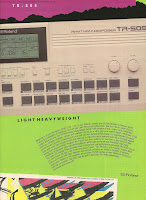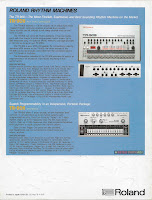Although it was in June 1987 that the R-50 started appearing in ads alongside the R-100 (see my last blog post), in November of that same year the R-50 finally got the spotlight to itself. This ad above appeared on and off until early 1988, getting bumped periodically by an ad for Kawai's additive synthesizer the K-5.
This ad was a big departure from the R-100/R-50 80s themed extravaganza that came before it - with a much more standard title/content/photo layout - and the content efficiently spelling out the features of the R-50, including its polyphony, pitch and pan abilities, on-board effects, pad programmability, Midi out the wazoo, and... my favourite... the alternate sound chips. More on that in a second.
Although Keyboard never devoted a full review to the R-50, it did make the Updates & Short Takes section of the Magazine in the January 1988 issue. Yes, you heard that right. Although the R-50 began appearing in ads waaaaaay back in June 1987, it would be seven months before any kind of review showed up.
Wowza is right.
I do give Jim Aikins credit though - its a nice, small compact review - just like the R-50 itself. We end up with about two columns of content devoted to the machine.
Jim starts by pointing out that the $495 R-100 is about $300 cheaper than the R-50. I like this, because it lets me know that the R-100 was still on the market at this time. Also, I dig historical retail prices in general.
Much like my relatives would do when over for Christmas dinner, we first get a lot of chatter about what's missing in the younger sibling compared to its bigger brother (okay, maybe I'm projecting a bit).
- Buttons not velocity sensitive
- Half the memory
- 50 of the 100 patterns are non-programmable factory rhythms
- Song construction simplified (no repeat loops or tempo changes)
- No punch-in recording and song overdub features
- No DIN sync jacks
- In individual outputs
Geeez... sounding even more like me being compared to my older brother. :)
But, the R-50 did have a few improvements like those assignable pads I went on about in the last post, some new effects, and some amazing midi tricks including midi triggers.
And, because I can't, and won't, stop talking about them, Jim also mentions those alternate sound chips. Read what he had to say...
"Two additional plug-in voice chips ($129.00) suggested retail) are compatible between the R-100 and R-50. You have to open up the unit to install the new chips, but we're told that Kawai is planning to market a built-in switcher that will hold all three chips and let you choose whichever one you prefer for the current song.".
This is the first I've heard that Kawai had planned to market their own switcher for all three chips. I'm my head, I'm thinking this would have been a kit that gets installed at the shop.
But correct me if I'm wrong - I don't recall this ever on the marketing. And I'm wondering if maybe Kawai decided that rather than market a switcher, they decided to market a new R-50 entirely - the elusive R-50iii - that contained all three chips.
I just happen to have one of those R-50iii. Time to open 'er up and see how those chips are installed.



















































